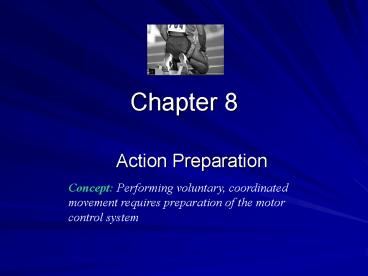Action Preparation PowerPoint PPT Presentation
1 / 12
Title: Action Preparation
1
Chapter 8
- Action Preparation
Concept Performing voluntary, coordinated
movement requires preparation of the motor
control system
2
The Question of Interest in this Chapter
- What does the motor control system do when we
get ready to perform an action in a specific
situation? - Action Action Action
- Intention Initiation Termination
Preparation
3
Action Preparation Requires Time
- Donders (1868), Dutch physician, began the
research that demonstrated the need for time for
the motor control system to prepare to produce an
intended action - RT (reaction time) is the commonly used index of
the preparation time required to produce action - Based on findings showing that RT is influenced
by many performance situation and performer
characteristics
4
Task and Situation Characteristics Influencing
Preparation
- Number of response choices
- Hicks Law
- RT increases logarithmically as the number of
stimulus-response choices increases See Fig. 8.1
- 2. Predictability of the correct response choice
- RT decreases as the predictability of the correct
response choice increases
5
Task and Situation Characteristics Influencing
Preparation, contd
- 3. Influence of the probability of precue
correctness - Precue an advance indication that a specific
upcoming event will require a response - Faster RT if probability of precue correctness is
higher than if probabilities of possible choices
are equally possible - e.g. 2 choices Right 80 Left 20
compare with 50 50 - Cost benefit trade-off for biasing anticipated
required response to the higher probability (if lt
100) See Fig. 8.2
6
Task and Situation Characteristics Influencing
Preparation, contd
- Stimulus-response compatibility
- RT decreases as the spatial relationship between
a stimulus and its response increases - Stroop effect
- Spatial arrangement of stimuli and their
associated response mechanisms - e.g., Stove top example see A Closer Look
- Foreperiod length regularity
- RT increases/decreases as a function of the
length and the regularity of the length of the RT
foreperiod - i.e., interval between warning and go signals
7
Task and Situation Characteristics Influencing
Preparation, contd
- Movement complexity
- RT increases as amount of complexity of the
action increases - First demonstrated by classic experiment by
Henry and Rogers (1960) See A Closer Look - Movement accuracy
- RT increases as movement accuracy demands of the
action increase - First demonstrated by evaluating RT results for
Fitts tapping tasks with different Indexes of
Difficulty (i.e. as MT increased, RT also
increased)
8
Task and Situation Characteristics Influencing
Preparation, contd
- 8. Repetition of a movement
- 9. Time between different responses to different
signals - Delay of response to 2nd stimulus (signal)is
called the psychological refractory period (PRP)
See Figure 8.3 - Relate to a situation in sports involving a
fake movement followed by the intended movement
as the 2 stimuli and the other players responses
as the 2 responses
9
Two Performer Characteristics Influencing
Preparation
- Alertness of the performer
- Warning signal effect
- Foreperiod length effect See Fig. 8.4
- Vigilance effects
- Attention focused on the signal vs. the movement
- RT benefits more from focusing on the signal
(e.g. sprint start in swimming)
10
Motor Control Events That OccurDuring Preparation
- Postural preparation
- Organization of movements needed for postural
support - Anticipatory characteristic of movement activity
involved in postural preparation - Flexible synergistic organization characteristic
of postural movement preparation
11
Motor Control Events That OccurDuring
Preparation, contd
- Limb performance characteristics
- e.g. Movement
- Direction
- Trajectory
- End-point accuracy (i.e. for a ballistic movement)
- Object control characteristics
- Force control
- End-state comfort position (i.e. hands final
spatial position as initial position)
12
Motor Control Events That OccurDuring
Preparation, contd
- Sequences of movements
- See research on piano playing as evidence
- Spatial coding
- Evidence from S-R compatibility research
- Rhythmicity preparation
- Preperformance rituals
- See examples in Table 8.1
- Research shows they appear to prepare relative
timing of upcoming movements

